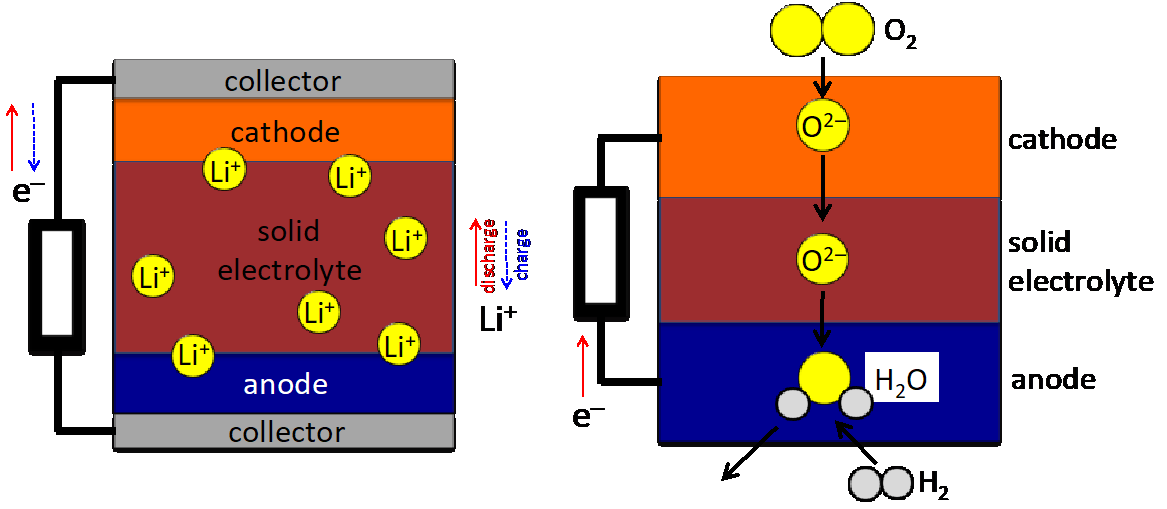| Program B03-1 | Development of highly spin polarized lithium and oxygen radioisotope beams for the study of battery materials |
|---|---|
| Principal Investigator | MIHARA, Mototsugu (Osaka University) |
Lithium ion batteries (LIBs) and fuel cells (FCs), which exhibit
excellent performance in rechargeability and electric power
generation, respectively, have been widely in practical use in recent
years and are becoming increasingly important. The next generation of
LIB and FC devices such as the all-solid-state LIB and the solid
state oxide FC (SOFC), respectively, are attracting a lot of
attention. Here, creating or finding new materials that have high
ionic conductivity is a key issue to achieve high performance in
these new devices. In order to evaluate such ion conducting
materials, reliable data for the ionic conductivity is
indispensable. The nuclear magnetic resonance (NMR) technique is a
promising method of the ion-conductivity measurement, which usually
utilizes stable nuclei as NMR probes that are naturally
abundant. However, in some cases the NMR sensitivity becomes
insufficient because of low concentration of probe nuclei in
materials. Since in the case of the LIB charge and discharge are
performed using the migration of lithium ions, there can be a place
where the Li ion concentration becomes low during the
charge-discharge cycles. Concerning the oxygen NMR, the natural
abundance of oxygen probe nucleus is quite low, so that it has been
difficult to advance the NMR study of the SOFC materials.
We approach this problem by using lithium and oxygen radioisotopes
(RIs) 8Li and 19O as NMR probes with which we
aim at measuring the
ion conductivity in LIB and FC materials. The beta-NMR technique
utilizing the beta-ray emission from RI enables the detection of NMR
with extremely high sensitivity which is more than 1010 times higher
than that of the conventional NMR. In order to achieve this, we
develop a new method to produce spin polarized 8Li
and 19O
beams. Nuclear reactions in inverse kinematics will be attempted, by
which highly polarized and intense RI beams are expected. This will

Schematic drawing of the
operating mechanisms of the all-solid-state lithium-ion battery
(left) and the solid state oxide fuel cell (right).
lead to the study of Li ion conduction in the low concentration
region or providing a new oxygen NMR probe. In addition, a small
energy spread in the RI beam can be achieved in this method, which
will make it possible to scan a specific part of an active device
such as electrode and electrolyte by controlling the implantation
depth of the beam. In this research plan, we aim to establish a new
method to evaluate ion conducting materials for LIB and FC devices.
Members
- Principal Investigator
-
MIHARA, Mototsugu
(Graduate School of Science, Osaka University)
- Research Collaborators
-
YAMAGUCHI, Hidetoshi (The University of Tokyo)
SUGIYAMA, Jun (Comprehensive Research Organization for Science and Society (CROSS))
Reference Materials
- M. Mihara, “Fundamentals of β-NMR and its new developments in materials science studies (in Japanese),” J. Surf. Sci. Soc. Jpn. 38, 188–193 (January 2017), DOI: 10.1380/jsssj.38.188 .
- K. Matsuta, T. Minamisono, M. Mihara et al., “Nuclear moments as a probe of electronic structure in material, exotic nuclear structure and fundamental symmetry,” Hyperfine Interact. 220, 21–28 (2013), DOI: 10.1007/s10751-013-0847-0.
- T. Minamisono et al., “Electromagnetic moments of the β-emitting nucleus 19O,” Phys. Lett. B 457, 9–16 (1999), DOI: 10.1016/S0370-2693(99)00468-2.
- K. Matsuta et al., “Creation of spin polarization in unstable nuclei and correlation-type experiments,” Nucl. Instrum. Methods Phys. Res. A 402, 229–235 (1998), DOI: 10.1016/S0168-9002(97)81652-X.
